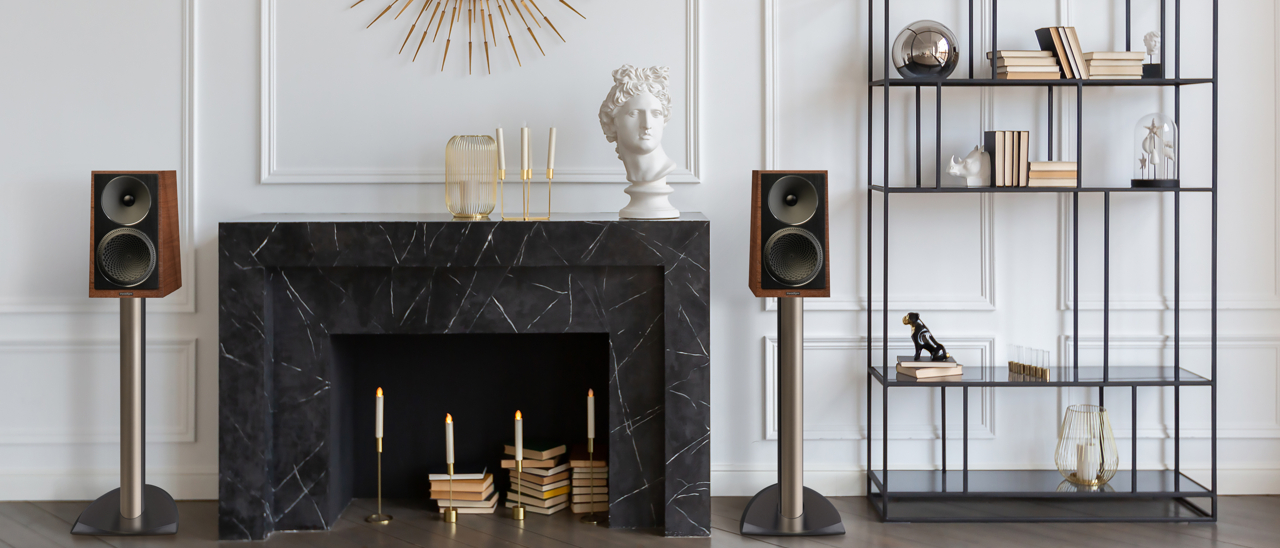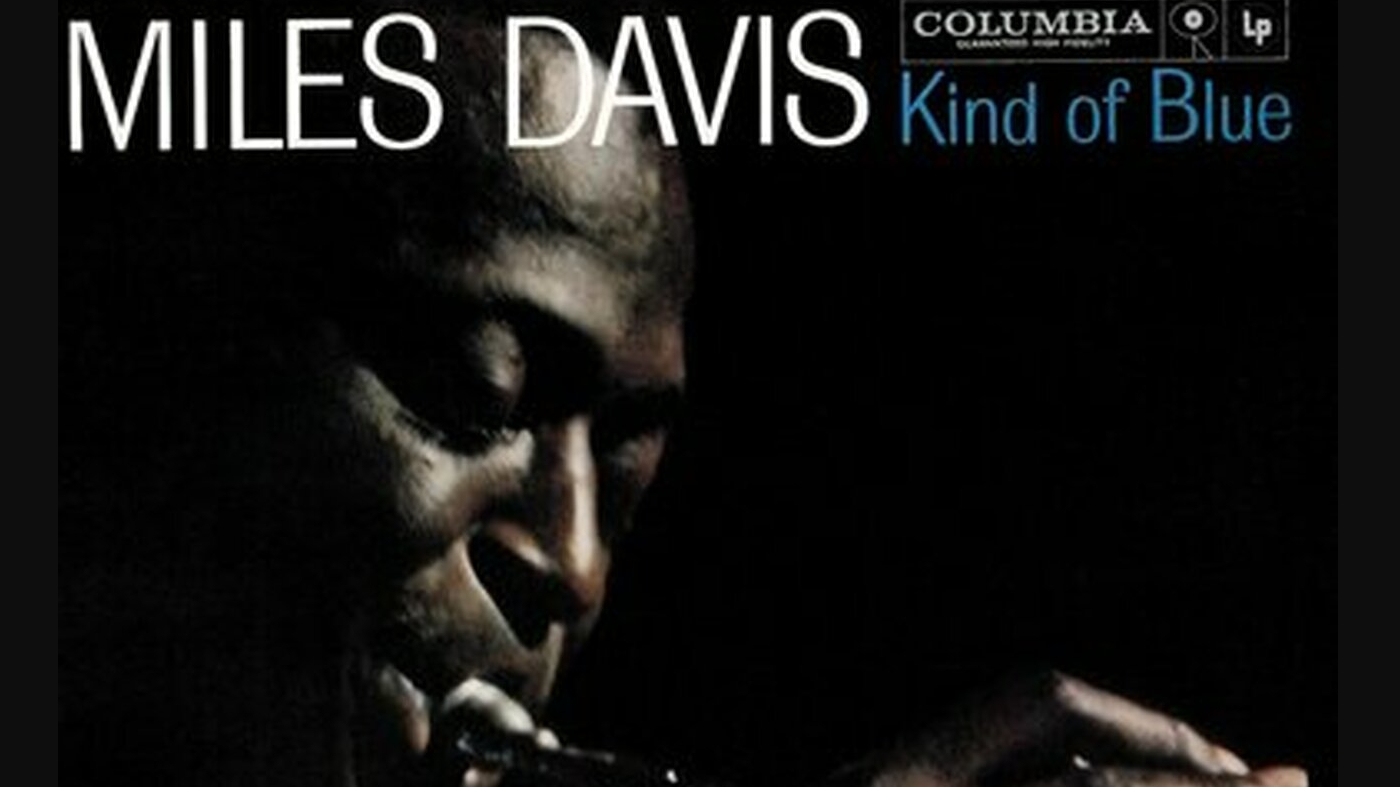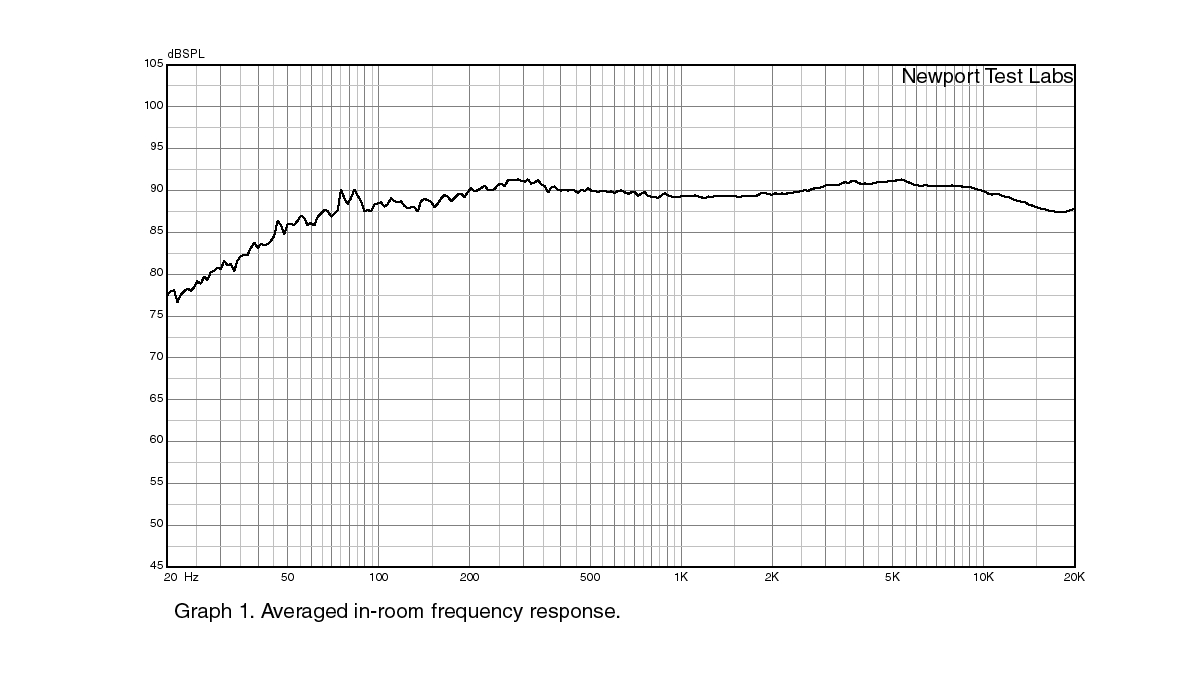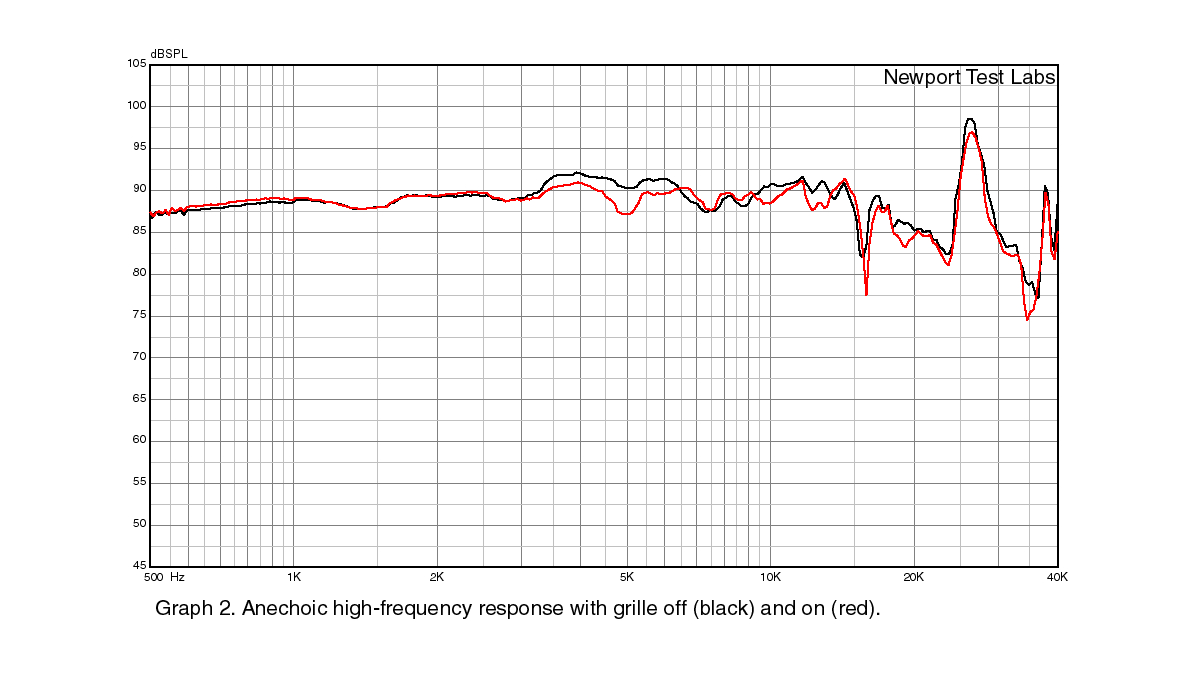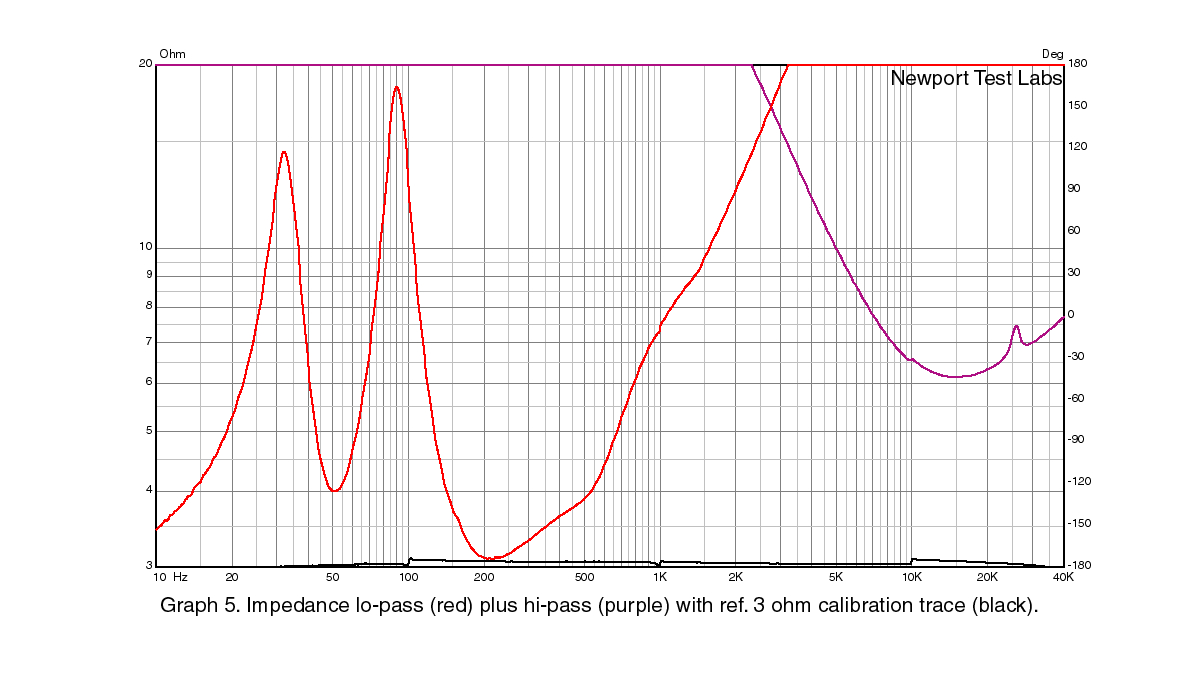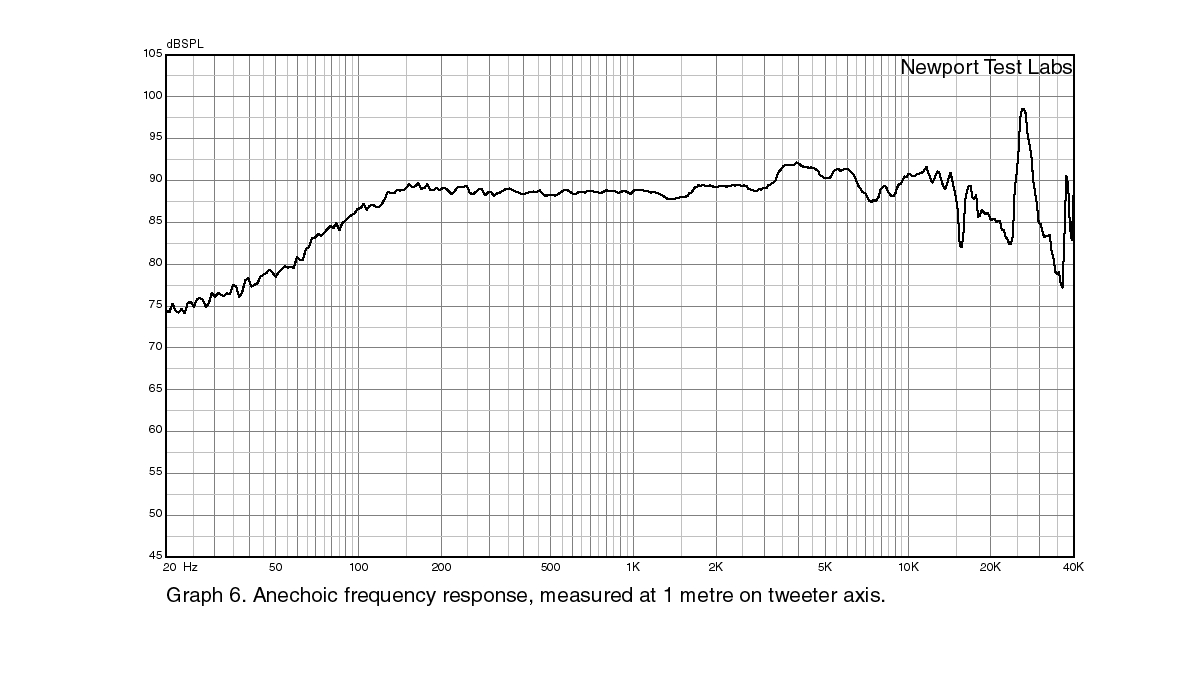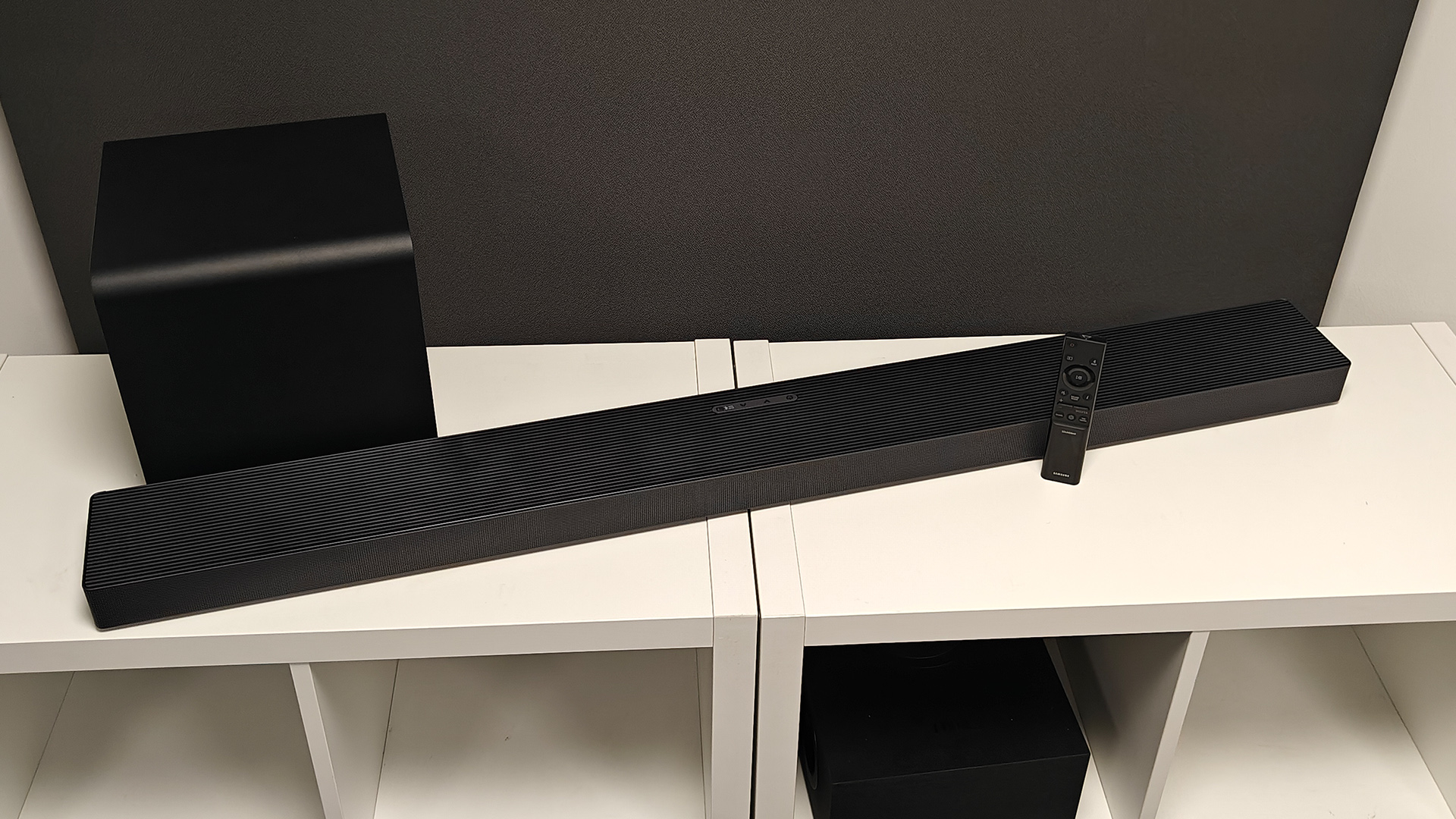What Hi-Fi? Verdict
Wonderful uncoloured monitor-like sound with bass you wouldn’t expect from a pair of small stand-mounters.
Pros
- +
Great imaging
- +
Excellent soundstage
- +
Highly efficient
- +
Superb sound
Cons
- -
Overuse of acronyms
- -
Lowish impedance
Why you can trust What Hi-Fi?

This review and test originally appeared in Australian Hi-Fi magazine, one of What Hi-Fi?’s sister titles from Down Under. Click here for more information about Australian Hi-Fi, including links to buy individual digital editions and details on how best to subscribe.
Never before was a speaker series so appropriately named! Paradigm’s Founder series is so-named because it’s the first completely new speaker series that has been built after Scott Bagby, the company’s original founder, re-established sole control over the Paradigm by buying out the shares held by private equity firm Shoreview Industries.
Shoreview had acquired a controlling interest in the company in 2005 following the departure of Jerry van der Marel who, with his brother Bill van der Marel and Bagby, had founded the company back in 1982.
Actually, Bagby did pretty well out of the deal, because he got Paradigm as part of a job lot of companies that means he also now owns the famous Canadian high-end brands Martin-Logan and Anthem. He also gets to work with his son John, who was – and still is – the General Manager at Paradigm.
In addition to the Founder 40B speakers reviewed here there are six other models in the Founder Series line-up – three floor-standing models (80F, 100F, 120H), a centre-channel (90C) and a surround speaker (70LCR). All models in the Founder range were designed and are manufactured at Paradigm’s own factory in Toronto, Canada.
Equipment
As you can see from the photographs, the Founder 40B is a two-way, bass-reflex bookshelf/stand-mount design. If you correctly guessed that the ‘B’ in the model number stands for ‘Bookshelf’, based on the fact that the model numbers of the floor-standing models I mentioned in the introduction are suffixed by the letter F and the centre-channel by the letter C you may now be wondering about the Founder 120H.
The ‘H’ stands for ‘hybrid’ because the 120 is a floor-standing design with passive high-frequency section and an active low-frequency section. The active low-frequency section comprises three 203mm diameter bass drivers driven by a 1,000-watt amplifier with built-in ARC Genesis room correction, so they can optimise their bass response to correct for room acoustics. (ARC stands for Anthem Room Correction.)
Paradigm sure likes its acronyms, abbreviations and trade-marks. It refers to the 25mm diameter dome tweeter in the Founder 40 as an “AL-MAG high-frequency driver with an OSW and a PPA lens”. What the AL-MAG bit means is that the tweeter’s dome is constructed from an alloy of aluminium and magnesium over which is a microscopically-thin ceramic coating.
The latest hi-fi, home cinema and tech news, reviews, buying advice and deals, direct to your inbox.
As for ‘OSW’, those initials stand for ‘Oblate Spherical Waveguide’. A waveguide is a solid structure that sits in front of a driver (in this case the dome of the tweeter) that beneficially interferes with the sound waves produced by the dome to either remove irregularities or improve dispersion (or, sometimes, to do both).

The shape of the Founder 40’s waveguide can be described as a half-revolution of an ellipse about its minor axis, which is technically known as an oblate spheroid, so you can see where Paradigm derived OSW.
As for exactly what the ‘OSW’ does, Paradigm says that it focuses the tweeter’s output at the listening position. Says the company: “As you move to the sides of the listening area, tweeter output gradually decreases, avoiding performance-robbing room reflections. Decreased output at the periphery of the room means that sound will not disrupt others that may be in earshot but wish to focus their attention elsewhere … OSW gives you better sound where you want it, and less distracting sound where you don’t.”
So what about those PPA initials? They stand for ‘Perforated Phase Aligning’ and it’s a type of lens positioned in front of the tweeter dome that not only protects it from damage, but is also intended to – again in the words of Paradigm – “ensure that all frequencies arrive at the listener’s ears at the same time.” There’s also a PPA lens in front of the bass/midrange driver, about which more in a moment, but let’s first look at the one on the tweeter.
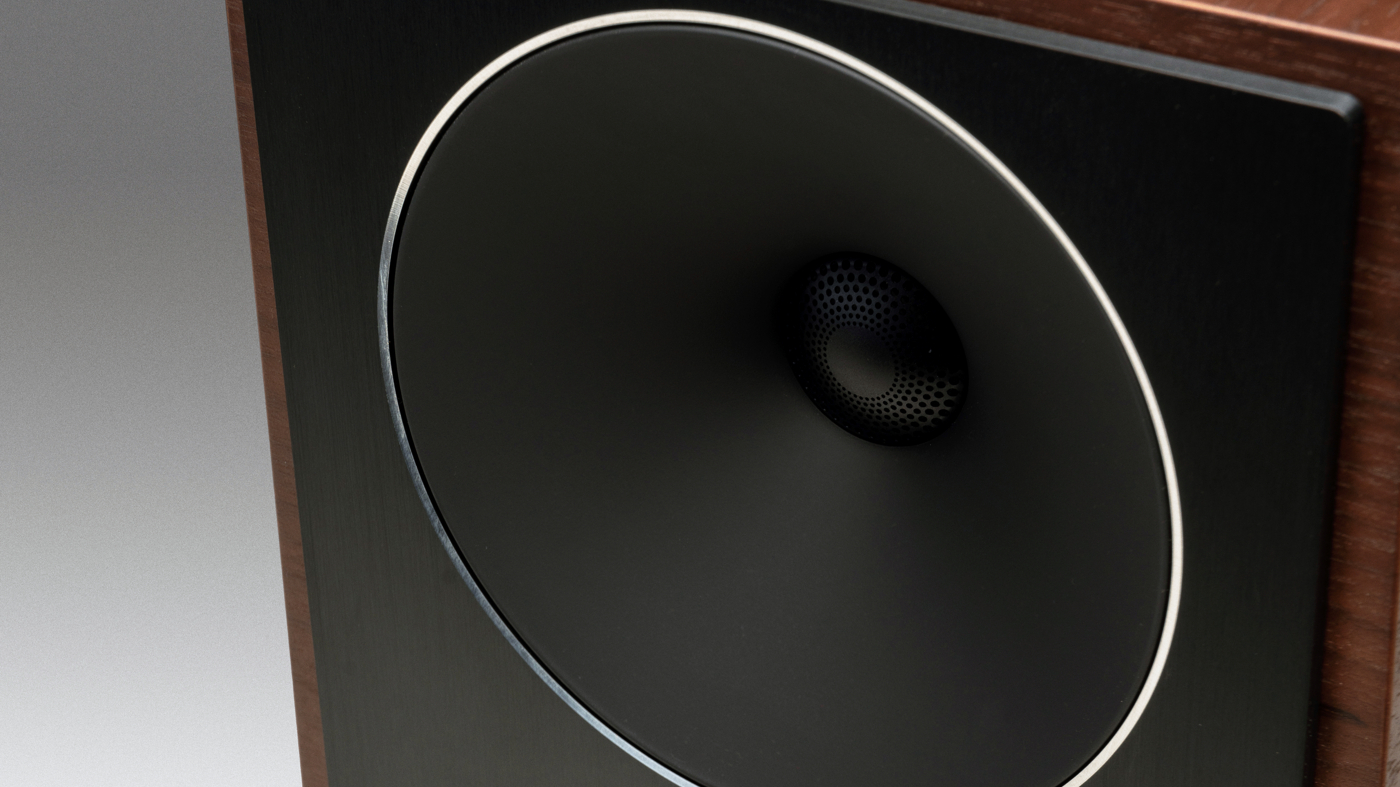
If you look at the ‘driver’ at the top of the Founder 40’s cabinet, the large conical structure you see (it’s 135mm wide, so it’s rather larger than a CD, which has a diameter of 120mm) is actually the oblate spherical waveguide and what you see right in the middle of it is a PPA lens, under which is the actual tweeter dome.
If you look carefully, you can see that the PPA lens actually blocks the sound waves coming directly from the dome and forces them through small perforations located lower down on the dome surface towards the waveguide, which then re-directs them towards the listening position.

There’s also a PPA lens in front of the bass/midrange driver. So what does this one do and how does it work? How might such a ‘lens’ “increase and smooth” the output of a bass/midrange driver?
One reason should be fairly obvious when you think about it. In any ‘cone’ loudspeaker, the cone moves inwards and outwards in a pistonic fashion to produce sound. So if the centre of the cone moves forwards and backwards one millimetre, the outside edge of the cone, where it joins with the roll surround, will also move forwards and backwards by one millimetre.
But because sound waves are quite short (a 4kHz sound wave is 11cm long) this means that the sound wave created at the centre of the cone will be slightly out of phase with the same sound wave that’s being created at the cone edge, and when the waves combine further in front of the driver there will be interference that will cause frequency response variations – increases when the sound waves are in-phase and decreases when they’re out-of-phase.
Essentially what Paradigm is doing with its PPA lens is trying to minimise the deleterious sound-wave interactions while at the same time maximising the useful interactions. I say ‘trying to minimise’ because to do this perfectly, you’d need a slightly different PPA lens for every frequency the driver is capable of reproducing. Unlike some of Paradigm’s PPA lenses, which are made from plastic, the one on the Founder 40 is made from metal.
But that isn’t the end of the acronyms! The Founder 40B’s bass/midrange driver not only also sports a PPA lens (that obscures the underlying cone) but also Paradigm’s third-generation ‘Active Ridge Technology’ with ‘Vertical Mounting System’, or as the company puts it, ‘Gen3 ART with VMS.’
What all this means is that Paradigm has developed a new type of roll surround that it uses on the Founder 40B’s bass/midrange drivers. If you could take a close look at these surrounds you’d immediately see that instead of being a smoothly curved piece of material (manufacturers use various materials, including rubber, cloth, foam, thermoplastic, etc), the surrounds are both corrugated – ‘ridged’ – and curved. It’s this unique profile that Paradigm calls ‘Active Ridge Technology, or ‘ART’. Rather unfortunately, you can’t see the ART on the Founder 40B because it’s obscured by the PPA!

Paradigm says these corrugations enable much greater driver excursion than a standard profile surround and that they also enable a driver to deliver higher sound pressure levels for the same input voltage, and with less distortion. Indeed Paradigm says the differences can be quantified as “an astounding, measurable 3dBSPL gain in output and a 50 per cent reduction in distortion”. Rather than gluing this unique surround to the cone, Paradigm ‘overmoulds’ the surround onto it, which provides a much stronger bond between the two.
Paradigm has been granted two US patents for its Active Ridge Technology, which was invented by Paradigm researchers Oleg Bogdanov and Kevin Stitt. One of these patents covers the ornamental design of the surround, while the other describes the function of the profile (in part) as “having a cross-sectional profile that varies continuously between each peak and adjacent trough so as to substantially eliminate unwanted stress-induced deformation during displacement of the diaphragm suspension when in use.”
As for the bass/midrange cone itself, it’s made from the same AL-MAG as the tweeter, has a dish-shaped dust cap and, according to Paradigm, has a diameter of 152mm. It’s driven by a 38mm high-temperature multi-layer voice coil that’s wound around a ventilated Apical former (or ‘bobbin’). Apical is a name trademarked by the Kaneka Corporation to describe the polyimide thermoset film it uses to make the bobbins that it supplies to Paradigm.
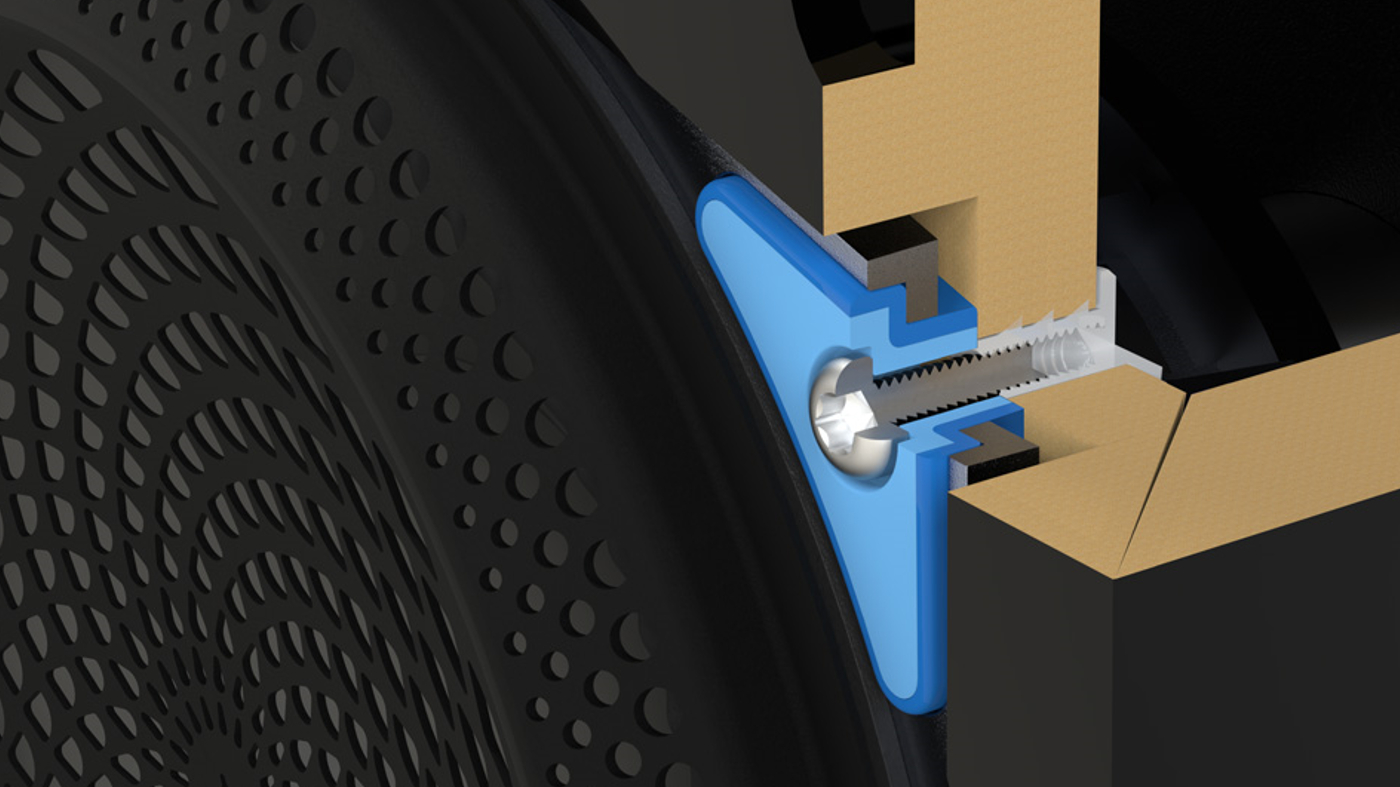
The bass/midrange driver is attached to the baffle with what Paradigm calls an “Advanced SHOCK-MOUNT™ Isolation". Although I am not surprised that Paradigm is using isolastic shock-mount fittings to isolate the driver from the baffle (because many manufacturers now do this), I am rather surprised that the company was able to trademark the words ‘Shock-Mount’ since most of the dictionaries I consulted contained the words as one word, two words, or hyphenated, with a definition along the lines of: “A mount used with sensitive equipment to reduce or prevent transmission of shock motion to the equipment.” Maybe in Canada you’re allowed to trademark common words if they’re in capital letters.
For the record, Paradigm’s definition of the words is: “This special mounting hardware uses an elastomer suspension to prevent any transfer of vibration from the driver to the cabinet, and from the cabinet to the driver. By eliminating resonance, the driver is free to render sound purely and efficiently with no audible distortion and maximum clarity” but since a picture is worth a thousand words, I’ve included one from Paradigm showing its “Advanced SHOCK-MOUNT™ Isolation” system.
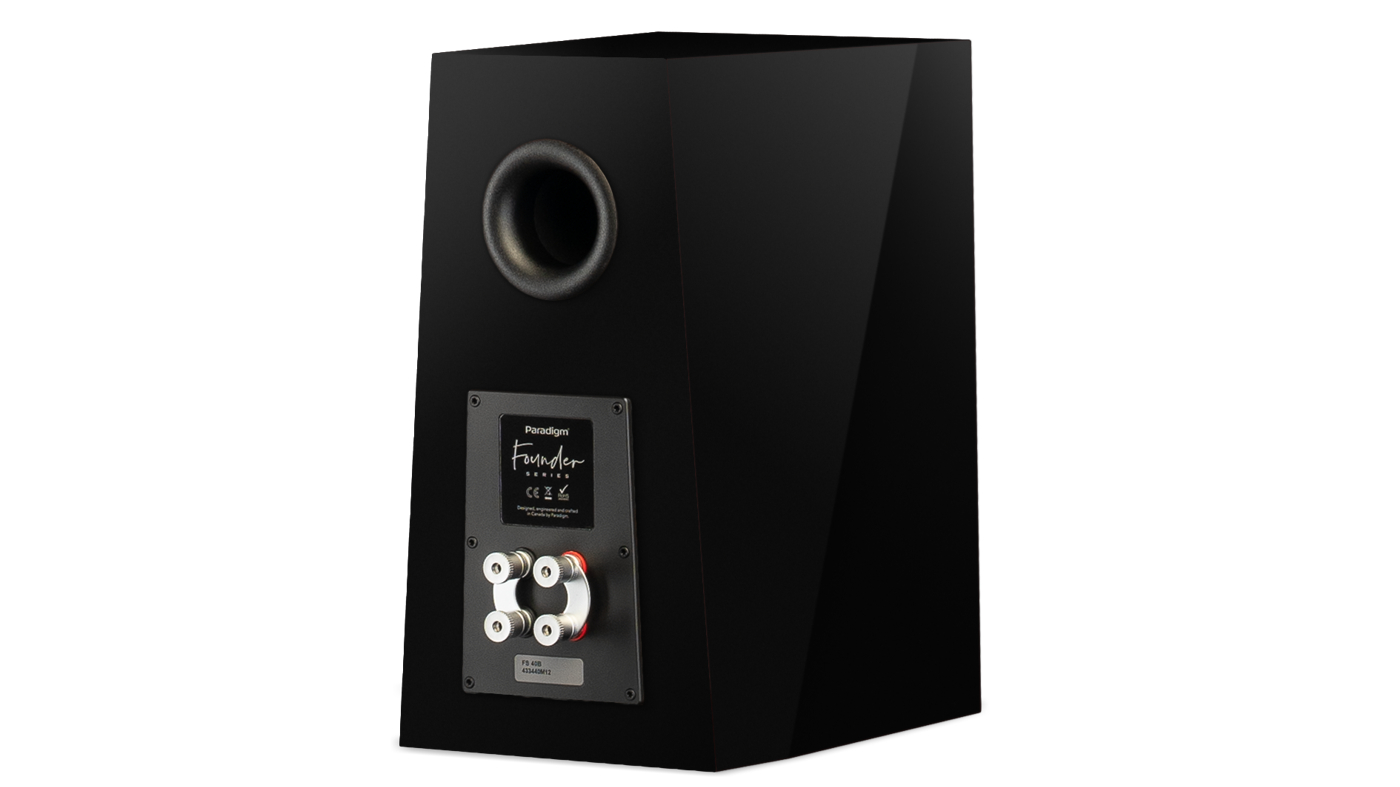
The Paradigm Founder 40 is a bass reflex design that is ported at the rear of the cabinet, with the port exiting above the dual speaker terminals. The port is 48mm in diameter, 152mm long and flared at its exit, but not internally.
If you look at the measurements of the Paradigm Founder 40’s cabinet, you’ll see them listed as 368×197×320mm (HWD), but this doesn’t really tell the story, because the cabinet is not your usual rectangular prism (or ‘cuboid’), but instead has a multi-faceted carcass that involves sides that are both angled and tapered, so that the base is wider than the top and the baffle is wider than the rear panel.
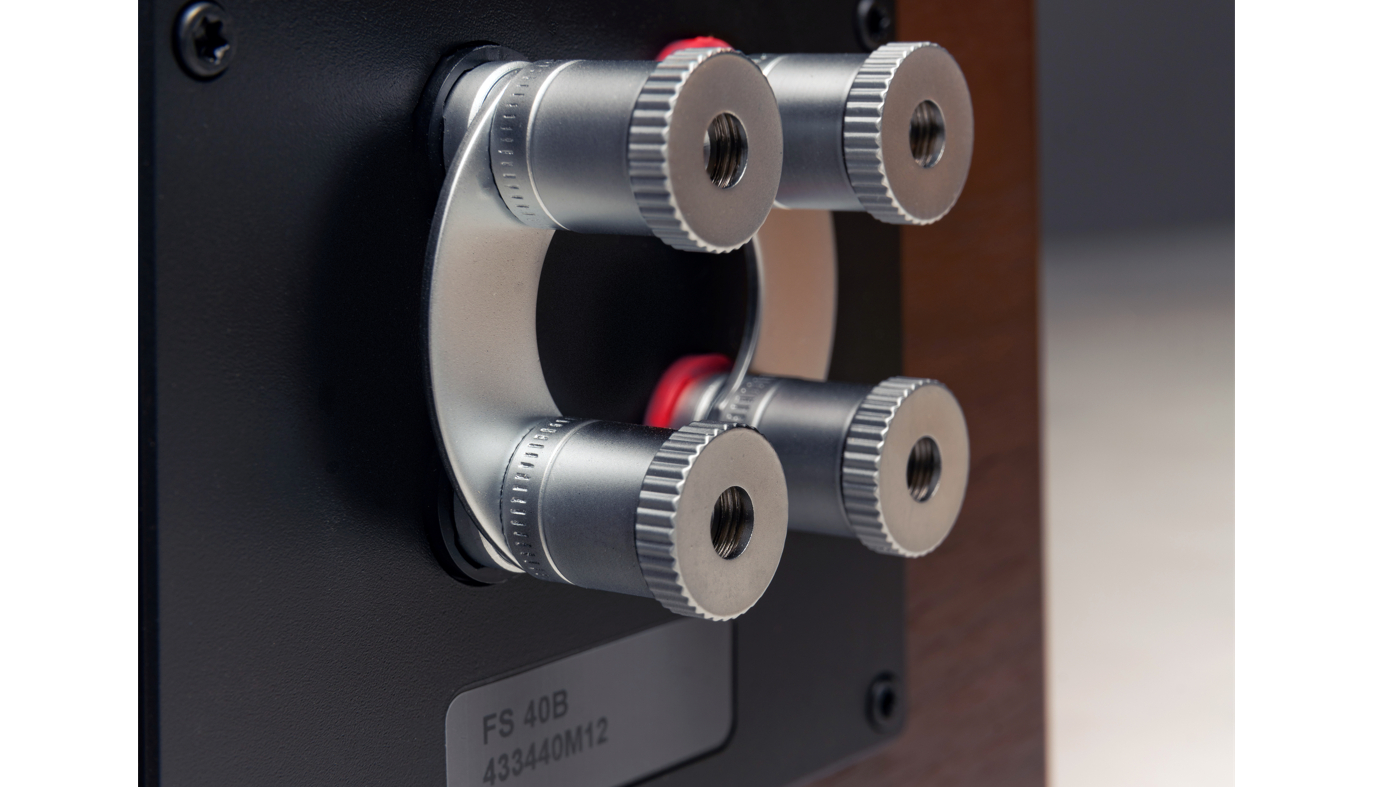
Inside the cabinet, Paradigm says it uses ‘Cascade-Fusion Bracing’ (CFB) to “increase rigidity and break up standing low-frequency waves. This delivers much tighter bass with greater clarity and accuracy. All bracing is extensively reinforced, making the cabinet into a monolith stronger than the sum of its parts.
The inherent strength of the geometric cabinet profile distributes the load points across a larger cabinet area providing greater support and rigidity than can be achieved with traditional square cabinet geometry.”
The Founder 40B is available in Piano Black, Black Walnut, Midnight Cherry, and Walnut finishes. Dedicated stands are available as an optional, added-cost extra.
Research and development
Paradigm has always combined measurements with listening sessions, but it’s a relatively small company, so initially it partnered with the Canadian Government’s famous acoustic laboratories at the National Research Council, where none other than the famous Floyd E. Toole was working at the time.
However, the company decided to bring things ‘in-house’ both for privacy and speed reasons and to this end head-hunted two of the NRC’s researchers to facilitate this, with the result being that Paradigm’s factory in Toronto is now also home to the largest privately-owned anechoic chamber in North America, with a size of almost 1,000 cubic metres.
As for the manufacturing side of Paradigm’s factory, as distinct from the research and development side (PARC, the Paradigm Advanced Research Centre, located in Ottawa, is a state-of-the-art laboratory dedicated to designing and programming electronics, and software) the company does almost everything in-house.
It builds all its own cabinets from scratch, including cutting, assembly, veneering, painting and polishing, as well as all the grilles it uses, for which it has moulds and heat presses. It also injection moulds all its own plastic components as well as its own loudspeaker cones and surrounds, plus it also winds its own voice coils. Paradigm also winds the inductors it uses in its crossovers, and assembles those crossover networks in-house.
The company also adheres to the same guiding principles it established when initially guided by the work at NRC, so that it uses blind listening when evaluating and comparing speaker designs, and aims for speakers that deliver smooth on-axis and off-axis frequency responses.
Listening sessions
If I were asked to identify the one thing that the Paradigm Founder 40Bs do better than anything else, I’d have my work cut out, because they do so many things so well, but if pressed, I’d have to say that what continually struck me the most when I was listening to them was their ability to seem as if they were not there at all, and that I was instead at the centre of a three-dimensional aural hologram that allowed me to be completely immersed in the music.
In the past, I’d have referred to this as a speakers’ ability to image and to sound stage – imaging and sound-staging, in other words – but Paradigm’s Founder 40Bs elevate both these highly desirable attributes to such high levels that these words just don’t seem to do justice to the sonic soundscapes these loudspeakers are able to create in your room.
And while some loudspeakers can do this if you sit exactly in the ‘sweet spot’ and don’t move your head more than a few millimetres in any direction, the Founder 40Bs can pull the ‘sweet spot’ trick over a wide enough area to accommodate multiple listeners.
As for what else they do well, I would immediately nominate the incredible realism of their sound right across the midrange and up into the high frequencies. The sound is so true-to-life that the tonality of instruments and the special talents of the musicians playing those instruments is instantly apparent.

You will never be left wondering who is playing when you hear an instrumental entry. Indeed you will not only be able to instantly say “that’s Blue Mitchell playing” but instead that “that’s Blue Mitchell playing his Committee” or “that’s Blue Mitchell playing his F.E. Olds” (those being two of the different makes of trumpet Mitchell played in his all-too-short career).
Similarly, if you’re listening to some Miles Davis and you hear a tenor sax come in, you’ll know straight away if it’s Land or Coltrane playing, or if it’s an alto that’s taking the break, whether you are listening to it being played by Stitt, Konitz or Carter.
And even if you don’t know the signature sounds of all these different musicians, the Paradigm Founder 40Bs will reveal to you that you are listening to different musicians, even though they’re playing the same instruments. These speakers are that good.
When you are listening to your favourite female vocalist, what you will hear if you are listening to her via the Founder 40Bs is a total lack of colouration. These speakers are just so accurate at delivering the exact sound of the human voice, without adding any unwanted ‘flavour’.
If you’d like to hear a demonstration of what I mean by colouration, ask your other half to sing you a short phrase, then form their hand into a short trumpet in front of their mouth and sing the same phrase again, then cup their hand a few centimetres in front of their mouth and do it again.
What you are hearing when you hear the second and third phrases are perfect examples of colouration – you can tell it’s your other half singing, but it doesn’t sound right. (If your other half would prefer not to sing, having them recite their mobile phone number will do nearly as well.)
This level of performance may well be a revelation to you, in that it may very well give you a whole new appreciation for your favourite artists. For example, I am a huge Joni Mitchell fan, and my own speakers are exceedingly accurate (and much more expensive than the Founder 40Bs!) but I thought that I was able to appreciate her voice rather better with the Founder 40Bs than I was with my own speakers. T
he Paradigms enabled the quality of her voice – and the purity of her singing – to be that tiny bit more evident. The Founder 40Bs will also enable you to hear the difference in sound between Mitchell’s Appalachian dulcimer and, for example, the similar-sounding langeleik.
I am not a huge Laurie Anderson fan, but I do like using her album ‘Big Science’ for evaluating high-frequency reproduction, because if I can hear the difference between the Farfisa and the VL-1 I know that the high-frequency sound is accurate, particularly on the track on this album you most likely will have heard even if you’re not an Anderson fan, which is O Superman. Perry Hoberman’s flute sound on this album is also a good high-frequency tester, and the Founder 40Bs passed the ‘Big Science’ test with flying colours.
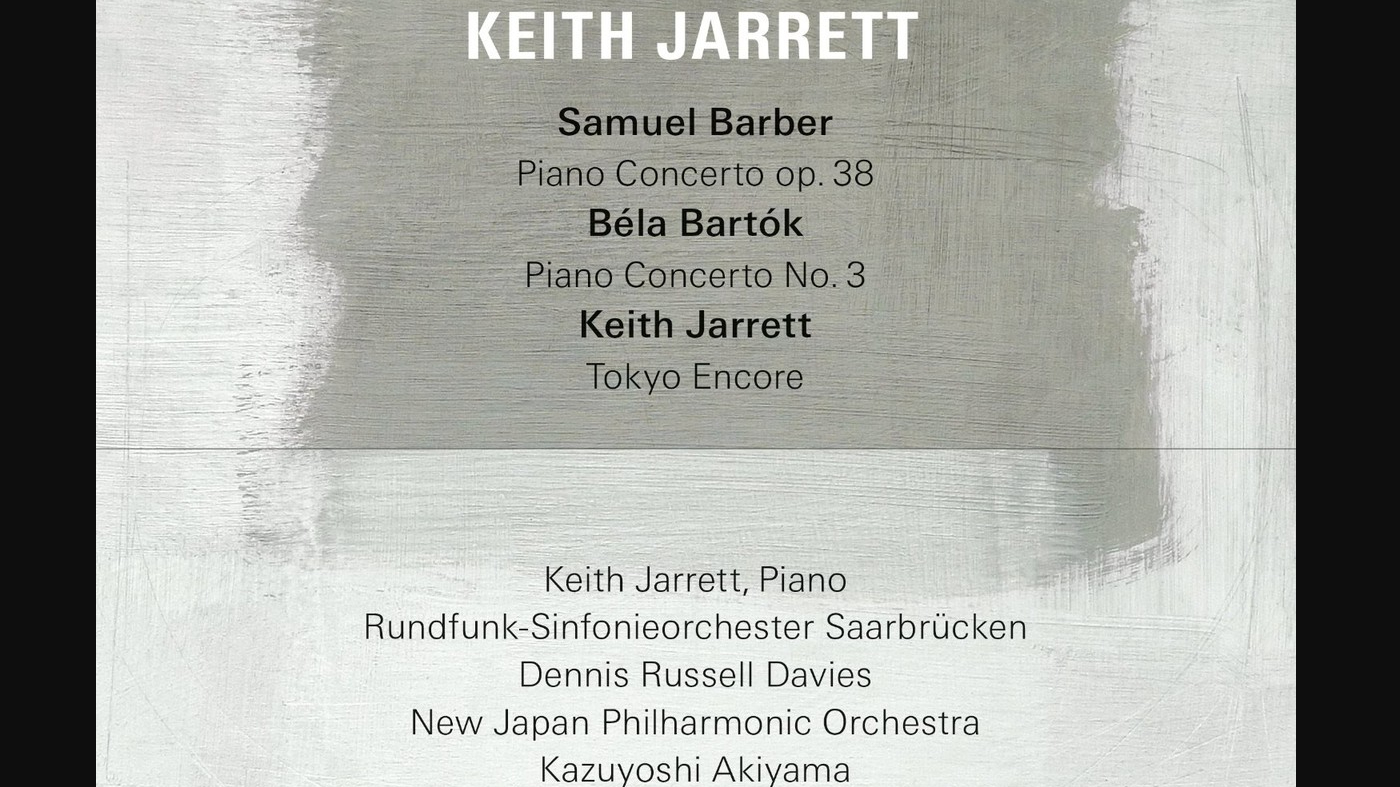
Of course if a loudspeaker cannot accurately reproduce the sound of a grand piano, it’s not worth its salt, and what better album to play the recording of Samuel Barber’s Piano Concerto Op38 that Keith Jarrett recorded with the Rundfunk-Sinfonieorchester Saarbrücken under Dennis Russell Davies (available on ECM).
Not only do we get to hear a beautifully recorded piano, but also a wonderfully recorded orchestral sound, rich in ultra-high frequencies. Listen particularly to the enraged string section, the blaring brass and the explosive percussion punctuation and how well the Paradigm Founder 40Bs deliver them. (Listen too, to the realism of the coughing in the audience and the sound of the acoustic of the venue!)
You can hear the superiority of the Founder 40Bs’ delivery by contrasting and comparing Jarrett’s piano sound on this same album when he’s playing Bela Bartok’s Piano Concerto No 3 with the New Japan Philharmonic, under Kazuyoshi Akiyama.
When listening using the Founder 40Bs you can hear the differences in the sound of the piano, in the orchestra, in the halls… you can hear everything clearly. Most spectacularly, you can actually hear the emotional differences between the two performances, not just the sonic differences. This is what loudspeakers should do! The sonorities of the violin sound in the Bartok are gloriously delivered by the Founder 40Bs.
As for the bass delivery of the Founder 40Bs, I have often been disappointed when I have independently cross-checked the performance of small speakers that other reviewers have claimed ‘punch above their weight’ or ‘deliver hard-hitting bass’ or ‘bigger bass than could be imagined’. Indeed I have been disappointed on so many occasions that I wondered if those reviewers were actually listening to the same speakers I was listening to.
Newsflash! Most small loudspeakers deliver almost exactly the same bass – both in terms of extension and level. It’s just physics. So it’s with some trepidation that I write here of the Paradigm Founder 40Bs that you really are not going to believe the depth of the bass they deliver, or the quality of that bass until you hear them yourself. Don’t take my word for it.
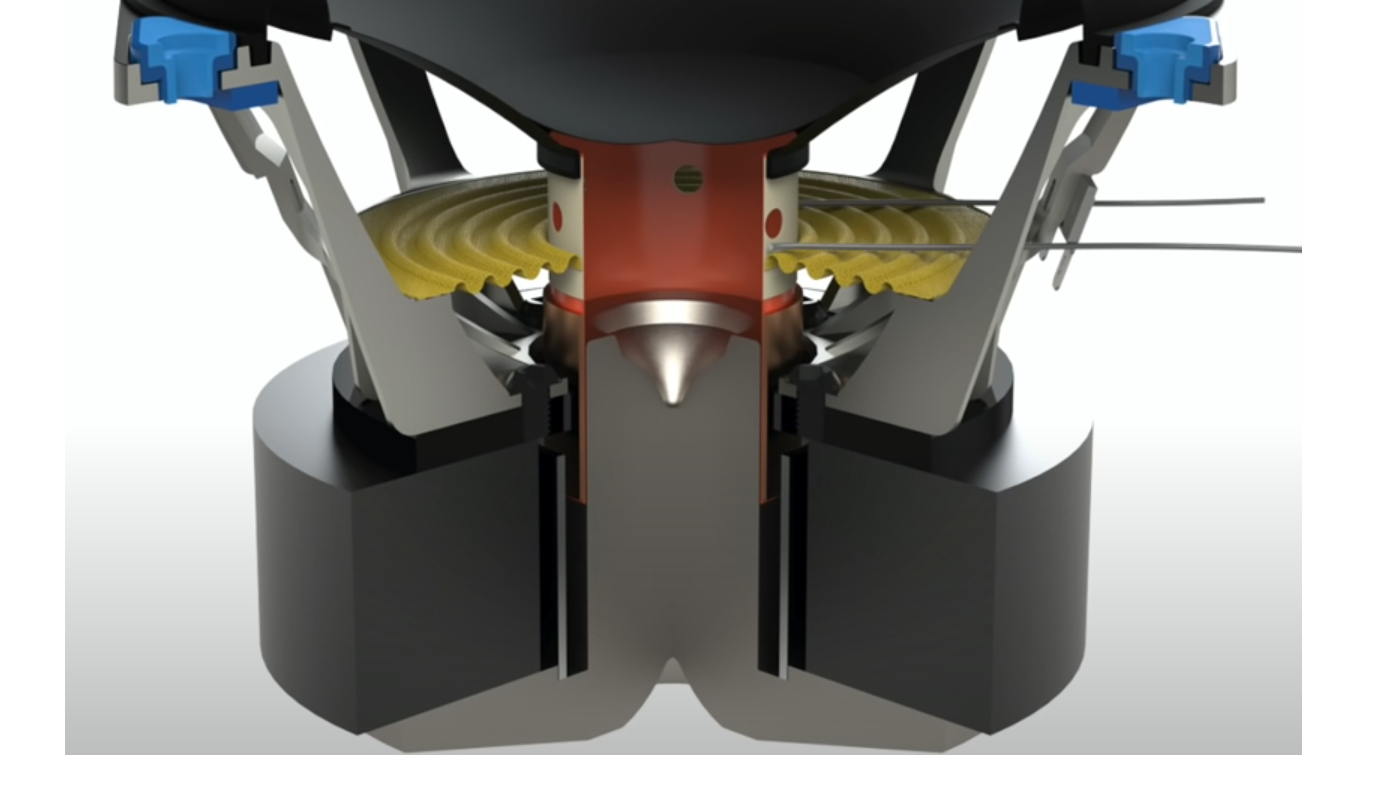
Indeed I was so surprised that I wondered how Bagby had managed it until I saw the size of the magnet and voice coil that he designed to drive the Founder 40B’s bass/midrange cone. They are so large that reviewer Steve Guttenberg suggested they’re what you’d find in the driver used for a subwoofer. They aren’t, of course, but the bass/midrange driver in the Founder 40B certainly has a larger magnet and voice coil than I have ever seen in a driver in a cabinet of the Founder 40B’s size.
The incredible cone excursion enabled by Paradigm’s Active Ridge Technology is no doubt another factor enabling this superb low-frequency performance. But, as I said, previously, don’t take my word for it…
Verdict
Paradigm is a long-established, highly reputable company that has built a well-deserved reputation for quality and reliability, as well as for building products that sound great. And importantly for me – and possibly for you as well – it continues to design and build those products entirely in Canada.
If I were in the market for a pair of small bookshelf/standmount loudspeakers, the Paradigm Founder 40Bs are the ones I would buy!
- Best standmount loudspeakers 2021
- How to choose the right speakers for best sound
- 12 of the world's most expensive loudspeakers
In-depth laboratory test report
Newport Test Labs first tested the in-room frequency response of the Paradigm Founder 40B speakers, using a pink noise test signal, the result of which is shown in Graph 1, below.
You can immediately see from this graph that the frequency response returned by the Paradigm Founder 40B was incredibly flat and linear and also well-extended at both ends of the audio spectrum. Across the region from 200Hz to 10kHz, which includes everything from the upper bass to the extreme treble, the response is essentially within ±1dB. It’s not so long ago that you wouldn’t get as flat a response from an amplifier!
You can see that above 10kHz the response rolls off very slightly, to be 2.5dB down at 20kHz, but it’s obvious that it’s starting to rise again above 20kHz, as we’ll see in Graph 2. Below 200Hz you can see the response rolls off around 2.5dB to 140Hz, at which level it basically shelves down to 65Hz, after which it rolls off very smoothly and gently.
Graph 2 shows the Paradigm Founder 40B’s high-frequency response, as it would be measured anechoically, so there are no room effects at all, using an incredibly precise measurement technique that delivers an enormously detailed response. Newport Test Labs made the measurement twice: once with the grille off (the black trace) and again with the grille in place (the red trace).
The increased detail of this measurement technique allows us to see that there’s a tiny suck-out in the response at 16kHz that is somewhat sharper and deeper with the grille on than it is with the grille off. This is, however, of no account since the bandwidth is too narrow for the human ear to perceive (not to mention as well as the frequency being far above the highest note any instrument can play).
You can see on this graph that the Paradigm Founder 40B’s frequency response actually extends fairly flat out to 14kHz, after which there’s the dip, after which it again rolls off to 23kHz at which frequency we can see a large tweeter resonance that peaks at around 26kHz. There’s then another resonance at 38kHz and then yet another that peaks higher than 40kHz.
The main high frequency resonance at 26kHz is presumably caused by the tweeter’s metal dome itself while the two higher-frequency resonances are presumably caused by the metallic PPA lens that covers it. However, you can safely ignore them all, because all occur at frequencies far above the limit of human hearing (typically 20kHz for those under 30 years old, and decreasing with increasing age).
Graph 3 shows the low frequency response of the Paradigm 40B as measured by Newport Test Labs using a near-field technique that simulates the response that would be obtained measuring the speakers in an anechoic chamber, and allows the lab to separate the output of the bass/midrange driver (the black trace) from that of the rear-firing bass reflex port (the red trace).
You can see that the bass/midrange driver’s response starts rolling off quite steeply below 100Hz to a minima at 55Hz, before rising a little to 30–40Hz before then rolling off again. You can also see that the port’s output is compensating for this by rising smoothly and steeply from 20Hz to peak between 40 and 50Hz, before rolling off fairly shallowly to 100Hz, then steeply thereafter.
There is a little unwanted high-frequency leakage evident through the port at around 1kHz, but it’s so low in level that it would not affect the output from the bass/midrange driver.
The impedance modulus of the Paradigm Founder 40B as measured by Newport Test Labs is shown as the red trace in Graph 4, with the phase angle measured shown as the blue trace. You can see that when Paradigm’s specification states that the speakers are ‘Compatible with 8Ω’ this seems to be a way of avoiding mention of the fact that the impedance dips below 4Ω between 190Hz and 500Hz, with a minimum of around 3.1Ω at 210Hz. Under IEC guidelines, the ‘nominal’ impedance of the Founder 40B would be 4Ω, suggesting that any amplifier used to drive them should be capable of driving 4Ω loads. Despite the low impedance at low frequencies, the Founder 40B will present an easy load to the amplifier, because the phase angle is benign over the same frequency range.
The impedance trace shows that you shouldn’t expect any real acoustic output from the speaker below 50Hz and that there are no cabinet resonances. You can see the effect of the primary tweeter resonance at 26kHz, while the absence of resonance effects above this would suggest that the higher resonances on the frequency response are indeed coming from the tweeter’s PPA lens, as noted earlier in this test report.
Graph 5 shows the impedances you can expect to be presented to your amplifiers if you separate the high and low sections of the speaker by removing the jumper bridges from the speaker terminals and that the electrical crossover frequency is at around 2.8kHz, somewhat higher than the 1.6kHz stated in Paradigm’s specifications.
Graph 6 shows the overall frequency response of the Paradigm Founder 40B that was obtained by splicing the low-frequency in-room response to the anechoic high-frequency response. This shows that Newport Test Labs measured its Founder 40B’s frequency response as 75Hz to 23kHz ±4dB. This is not quite a match for Paradigm’s own specification of 69Hz–23kHz ±2dB, but it is remarkably close.
Newport Test Labs measured the sensitivity of the Paradigm Founder 40B as being 88.5dBSPL at one metre for 2.83Veq under its standard test conditions, which is a higher-than-usual result for a small bookshelf/standmount design, and therefore an excellent result, as well as being only just shy of Paradigm’s own specification of 90dBSPL.
All the tests and measurements performed on the Paradigm Founder 40B by Newport Test Labs prove that it has superb drivers and has been outstandingly well-designed.
Australian Hi-Fi is one of What Hi-Fi?’s sister titles from Down Under and Australia’s longest-running and most successful hi-fi magazines, having been in continuous publication since 1969. Now edited by What Hi-Fi?'s Becky Roberts, every issue is packed with authoritative reviews of hi-fi equipment ranging from portables to state-of-the-art audiophile systems (and everything in between), information on new product launches, and ‘how-to’ articles to help you get the best quality sound for your home.
Click here for more information about Australian Hi-Fi, including links to buy individual digital editions and details on how best to subscribe.
